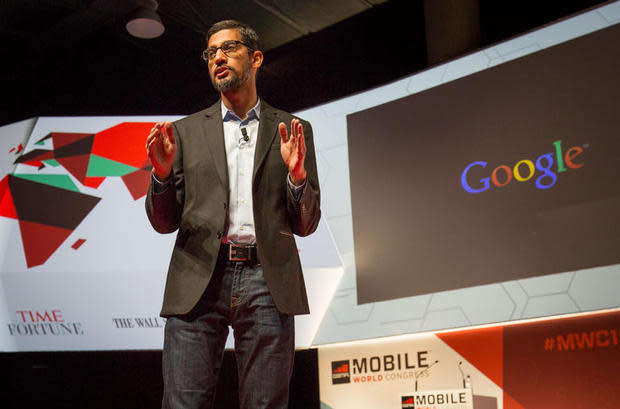MWC15: The Google announcements that matter

Sundar Pichai, Google's senior vice president of products, speaks at Mobile World Congress 2015.
Image: Stephen Shankland/CNET
Fresh on the heels of the CES, the Mobile World Congress (MWC) officially kicked off in Barcelona, Spain on Monday, March 2. The conference is one of the platforms where tech industry stalwarts and newcomers alike announce new products and business strategies for the year ahead.
Google was among those companies making its proclamations at MWC, spearheaded by a keynote address from Sundar Pichai, senior vice president of products. Pichai opened with some staggering statistics about the success of Google's products and services, such as user numbers for Chrome and Android, and the percentage of mobile transactions completed on Black Friday.
After briefly showcasing the new Samsung S6 and making brief statements on VR, Pichai launched into the remainder of his presentation on future projects in Google and Android. Here are the main takeaways from Pichai's 45 minute presentation at MWC.
Connectivity
Keeping people connected to the internet is paramount to Google's success. Pichai laid out three aspects of Google's connectivity strategy: Google Fiber, Project Loon, and Project Titan.
Google Fiber is perhaps Google's most well-known undertaking in directly keeping consumers connected, specifically in urban areas. And, undoubtedly, it will continue to be a big part of its future connectivity plans.
Project Loon was launched in 2013. It serves as a way to address the connectivity gap in rural areas. The basic concept is large balloons that float in the stratosphere above remote areas providing connectivity through cellular technology. Google has partnered with major telecom companies like Vodafone, Telstra, Telefonica to build out the technology.
Pichai mentioned some 4 billion people in the world not having access to connectivity, and now Loon balloons can stay up in the air, providing that connectivity, for six months at a time.
The third part of Google's strategy is Titan, a drone complement to project Loon. The name is likely derived from Google's purchase of Titan Aerospace early in 2014. Lightweight drones with cellular radios can quickly be sent to areas with immediate need for more connectivity. Pichai said that Google would be flying the drones soon.
"As expected, the drones from Project Titan will serve as another avenue for Google to provide wireless access to remote areas," said Gartner's Mark Hung. "It can do so either as a standalone drone network, or it could also complement the balloons from Project Loon."
MVNO
Last month, there was speculation that Google was making as play as a mobile virtual network operator (MVNO), becoming a provider of wireless service plans. When asked about the MVNO prospect, Pichai explained how Google is approaching it.
"I think we're at the stage where we need to think of hardware, software, and connectivity together," Pichai said. "Especially with things like watches. We don't intend to be a carrier at scale, and we're working with existing partners. You'll see some of our ideas come to fruit in the next few months."
Pichai said that Google had discussed the project with Verizon and AT&T, and he said Google is working with partners to do what they're working on.
That being said, the likely partner candidates for Google would be Sprint and T-Mobile, given that both have more unused spectrum than AT&T or Verizon and would probably be more willing to partner with the search giant.
Mobile web dominance would make an MVNO play especially advantageous for Google in terms of user behavior and data collection. However, Pichai said that Google will be using it to drive innovations such as automatically reconnecting dropped calls.
Android
Mobile payments got a huge push last year when Apple introduced Apple Pay, using NFC technology to make payments with a cell phone. It's the same technology Google used when it rolled out Google Wallet in 2011.
At MWC, Pichai explained Google's newest payments tool called Android Pay. It is an API layer in Android that allows developers to build a payment service onto Android. He also mentioned that Google Wallet, itself, will be a customer of Android Pay and it will work with NFC.
Pichai also gave an update on the Android One project for emerging markets. The project is continuing to focus on the $100 price point, but Pichai hopes to have that down around $50 in the next couple years.
Google+
The last of the big announcements was that Google will be focusing on one aspect of the social network. Pichai said that Google+ has always been seen as having two parts -- an activity stream and a social layer, and the company wants to pull out the social layer and focus on it. The social layer will continue to pivot around photos and communications, and the Hangouts tool will remain in service.
According to Gartner analyst Brian Blau, the breakup of Google+ had been hinted at for some time. Blau also said that it's possible Google rushed the product before it fully understood what the market wanted.
"The new focus on Hangouts, Streams, and Photos should help keep users engaged as the new services are more refined experiences and communities that look to be created with purpose in mind, and hopefully that will keep user interest high," Blau said.

